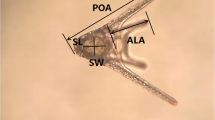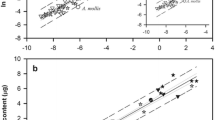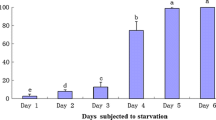Abstract
Food availability is highly variable in the ocean. Many species of marine invertebrates have a larval form that depends upon exogenous nutrients for growth, yet there are few biochemical and physiological indices for determining changes in the nutritional status of larvae. In this study, the effects of food availability on biochemical compositions and metabolic processes of larvae of the sea urchin, Strongylocentrotus purpuratus, were determined. Larvae were cultured under different food concentrations (fed-to-excess and unfed) and a suite of biological processes assayed, ranging from measurements at the level of the whole organism to that of specific molecules. These data were normalized to DNA content (an index of cell number) to allow comparisons of physiological rates in larvae of different sizes. Changes in the following were measured during larval growth: free amino acid pool, protein, lipid classes (cholesterol, free fatty acids, hydrocarbons, phospholipids, triacylglycerol), enzyme activities (Na+, K+-ATPase and citrate synthase), and respiration rates. In growing larvae, the two key components that showed differential cell-specific content relative to unfed larvae were glycine in the free amino acid pool and phospholipids. Additionally, several lipid classes were detectable only in fed larvae (cholesterols, free fatty acids, and hydrocarbons). While triacylglycerols were present in eggs and utilized during pre-feeding development, they were not re-accumulated at detectable levels in feeding larvae. Respiration rates, protein content, and enzyme activities were all similar on a cell-specific basis, showing that these variables did not provide useful indices of differences in physiological state between fed and unfed larvae. In contrast, measurements of the cell-specific content of glycine and certain lipid classes did provide useful indices of physiological state of larvae. Application of these indices could potentially allow for determinations of nutritional state of larvae in the ocean.





Similar content being viewed by others
References
Alberts B, Bray D, Lewis J, Raff M, Roberts K, Watson JD (1994) Molecular biology of the cell, 3rd edn. Garland Publishing, New York
Anger K (1995) Starvation resistance in larvae of a semiterrestrial crab, Sesarma curacaoense (Decapoda: Grapsidae). J Exp Mar Biol Ecol 187:161–174
Anger K, Dawirs RR (1981) Influence of starvation on the larval development of Hyas areneus (Decapoda: Majidae). Helgol Meeresunters 34:287–311
Blaxter JHS, Hempel G (1963) The influence of egg size on herring larvae (Clupea harengus L.). J Cons Int Explor Mer 28:211–240
Bligh EG, Dyer WJ (1959) A rapid method of total lipid extraction and purification. Can J Biochem Physiol 37:911–917
Boidron-Metairon IF (1988) Morphological plasticity in laboratory-reared echinoplutei of Dendraster excentricus (Eschscholtz) and Lytechinus variegates (Lamarck) in response to food conditions. J Exp Mar Biol Ecol 119:31–41
Brunk CF, Jones KC, James TW (1979) Assay for nanogram quantities of DNA in cellular homogenates. Anal Biochem 92:497–500
Buckley LJ (1984) RNA–DNA ratio: an index of larval fish growth in the sea. Mar Biol 80:291–298
Cameron RA, Britten RJ, Davidson EH (1989) Expression of two actin genes during larval development in the sea urchin Strongylocentrotus purpuratus. Mol Reprod Dev 1:149–155
Childress JJ, Somero GN (1990) Metabolic scaling: a new perspective based on scaling of glycolytic enzyme activities. Am Zool 30:161–173
Clarke ME, Calvi C, Domeier M, Edmonds M, Walsh PJ (1992) Effects of nutrition and temperature on metabolic enzyme activities in larval and juvenile red drum, Sciaenops ocellatus, and lane snapper, Lutjanus synagris. Mar Biol 112:31–36
Crisp DJ (1974a) Factors influencing the settlement of marine invertebrate larvae. In: Grant PT, Mackie AN (eds) Chemoreception in marine organisms. Academic, London, pp 177–265
Crisp DJ (1974b) Energy relations of marine invertebrate larvae. Thalassia Jugoslavica 10:103–120
Davidson EH (1976) Gene activity in early development, 2nd edition. Academic, New York
Davidson EH (1986) Gene activity in early development, 3rd edition. Academic, New York
Davidson EH, Hough-Evans BR, Britten RJ (1982) Molecular biology of the sea urchin embryo. Science 217:17–26
Fenaux L, Strathmann MF, Strathmann RR (1994) Five tests of food-limited growth of larvae in coastal waters by comparisons of rates of development and form of echinoplutei. Limnol Oceanogr 39:84–98
Fiske CH, Subbarow Y (1925) The colorimetric determination of phosphorus. J Biol Chem 66:375–400
Fry BJ, Gross PR (1970) Patterns and rates of protein synthesis in sea urchin embryos. II. The calculation of absolute rates Dev Biol 21:125–146
Gallager SM, Mann R, Sasaki GC (1986) Lipid as an index of growth and viability in three species of bivalve larvae. Aquaculture 56:81–103
Gnaiger E (1983) Calculation of energetic and biochemical equivalents of respiratory oxygen consumption. In: Gnaiger E, Forstner H (eds) Polarographic oxygen sensors: aquatic and physiological applications. Springer, Berlin, pp 337–345
Graeve M, Kattner G, Hagen W (1994) Diet-induced changes in the fatty acid composition of artic herbivorous copepods: experimental evidence of trophic markers. J Exp Mar Biol Ecol 182:97–110
Hadfield MG, Carpizo-Ituarte EJ, del Carmen K, Nedved BT (2001) Metamorphic competence, a major adaptive convergence in marine invertebrate larvae. Am Zool 41:1123–1131
Hinegardner R (1974) Cellular DNA content of the echinodermata. Comp Biochem Physiol B 49:219–226
His E, Seaman MNL (1992) Effects of temporary starvation on the survival, and on subsequent feeding and growth, of oyster (Crassostrea gigas) larvae. Mar Biol 114:277–279
Hochachka PW, Somero GN (1984) Biochemical adaptation. Princeton University Press, Princeton
Hoegh-Guldberg O, Emlet RB (1997) Energy use during the development of a lecithotrophic and a planktotrophic echinoid. Biol Bull 192:27–40
Hoegh-Guldberg O, Manahan DT (1995) Coulometric measurement of oxygen consumption during development of marine invertebrate embryos and larvae. J Exp Biol 198:19–30
Holland DL (1978) Lipid reserves and energy metabolism in the larvae of benthic marine invertebrates. In: Sargent DC, Malins JR (eds) Biochemical and biophysical perspectives in marine biology. Academic, London, pp 85–123
Holland DL, Gabbott PA (1971) A micro-analytical scheme for the determination of protein, carbohydrate, lipid and RNA levels in marine invertebrate larvae. J Mar Biol Ass UK 51:659–668
Hurlbert SH, White MD (1993) Experiments with freshwater invertebrate zooplanktivores: quality of statistical analyses. Bull Mar Sci 53:128–153
Jaeckle WB, Manahan DT (1989) Growth and energy imbalance during the development of a lecithotrophic molluscan larva (Haliotis rufescens). Biol Bull 177:237–246
Kattner G, Graeve M, Calcagno JA, Lovrich GA, Thatje S, Anger K (2003) Lipid, fatty acid and protein utilization during lecithotrophic larval development of Lithodes santolla (Molina) and Paralomis granulose (Jacquinot). J Exp Mar Biol Ecol 292:61–74
Lee JJ, Calzone FJ, Britten RJ, Angerer RC, Davidson EH (1986) Activation of sea urchin actin genes during embryogenesis. Measurement of transcript accumulation from five different genes in Strongylocentrotus purpuratus. J Mol Biol 188:173–183
Leong PK, Manahan DT (1997) Metabolic importance of Na+, K+-ATPase activity during sea urchin development. J Exp Biol 200:2881–2892
Manahan DT (1990) Adaptations by invertebrate larvae for nutrient acquisition from seawater. Am Zool 30:147–160
Manahan DT, Davis JP, Stephens GC (1983) Bacteria-free sea urchin larvae take up neutral amino acids selectively from seawater. Science 220:204–206
Marsh AG, Manahan DT (1999) Accurate measurements of the respiration rates of marine invertebrate embryos and larvae. Mar Ecol Prog Ser 184:1–10
Marsh AG, Leong PK, Manahan DT (1999) Energy metabolism during embryonic development and larval growth of an Antarctic sea urchin. J Exp Biol 202:2041–2050
McEdward LR, Herrera JC (1999) Body form and skeletal morphometrics during larval development of the sea urchin Lytechinus variegatus (Lamarck). J Exp Mar Biol Ecol 232:151–176
Moran AL, Manahan DT (2004) Physiological recovery from prolonged starvation in larvae of the Pacific oyster Crassostrea gigas. J Exp Mar Biol Ecol 306:17–36
Olson RR, Olson MH (1989) Food limitation of planktotrophic marine invertebrate larvae: does it control recruitment success? Ann Rev Ecol Syst 20:225–247
Paulay G, Boring L, Strathmann RR (1985) Food limited growth and development of larvae: experiments with natural seawater. J Exp Mar Biol Ecol 93:1–10
Platt T, Fuentes-Yaco C, Frank KT (2003) Marine ecology: spring algal bloom and larval fish survival. Nature 423:398–400
R Development Core Team (2005) R: a language and environment for statistical computing. R Foundation for Statistical Computing. Vienna. Available at http://www.R-project.org
Schmidt-Nielsen K (1986) Scaling: why is animal size so important? Cambridge University Press, New York
Sewell MA (2005) Utilization of lipids during early development of the sea urchin Evechinus chloroticus. Mar Ecol Prog Ser 304:133–142
Sewell MA, Cameron MJ, McArdle BH (2004) Developmental plasticity in larval development in the echinometrid sea urchin Evechinus chloroticus with varying food ration. J Exp Mar Biol Ecol 309:219–237
Shilling FM, Manahan DT (1990) Energetics of early development for the sea urchins Strongylocentrotus purpuratus and Lytechinus pictus and the crustacean Artemia sp. Mar Biol 106:119–127
Shilling FM, Manahan DT (1994) Energy metabolism and amino acid uptake during early development of antarctic and temperate echinoderms. Biol Bull 187:398–407
Srere PA (1969) Citrate synthase. In: Lowenstein JM (ed) Methods in enzymology, vol 13. Academic, New York, pp 3–11
Starr M, Himmelman JH, Therriault JC (1990) Direct coupling of marine invertebrate spawning with phytoplankton blooms. Science 247:1070–1074
Taylor JG (1982) An introduction to error analysis. University Science, Mill Valley
Thorson G (1950) Reproductive and larval ecology of marine bottom invertebrates. Biol Rev 25:1–45
Vardeman SB, Jobe JM (2001) Statistical quality assurance methods for engineers. Wiley, New York
Weiss GM, McManus GB, Harvey HR (1996) Development and lipid composition of the harpacticoid copepod Nitrocra spinipes reared on different diets. Mar Ecol Prog Ser 132:57–61
Yasumasu I, Hino A, Suzuki A, Mita A (1984) Change in the triglyceride level in sea urchin eggs and embryos during early development. Dev Growth Diff 26:525–532
Younger MS (1979) Handbook for linear regression. Duxbury Press, North Scituate
Acknowledgments
The authors are grateful to Drs. Simon Tavaré and Claudia Rangel Escareño of the University of Southern California for their advice on error propagation and statistical analysis. All experiments included in this study comply with current US laws regarding biological research on marine invertebrates. This work was supported by National Science Foundation Grant Number 0130398.
Author information
Authors and Affiliations
Corresponding author
Additional information
Communicated by J.P. Grassle.
Rights and permissions
About this article
Cite this article
Meyer, E., Green, A.J., Moore, M. et al. Food availability and physiological state of sea urchin larvae (Strongylocentrotus purpuratus). Mar Biol 152, 179–191 (2007). https://doi.org/10.1007/s00227-007-0672-6
Received:
Accepted:
Published:
Issue Date:
DOI: https://doi.org/10.1007/s00227-007-0672-6




